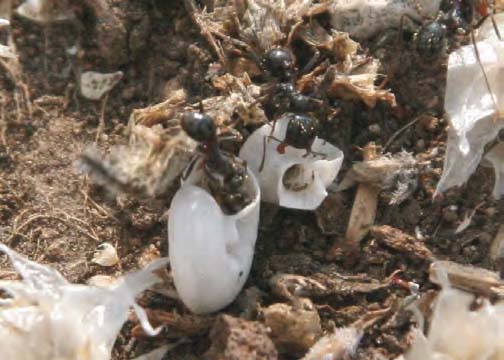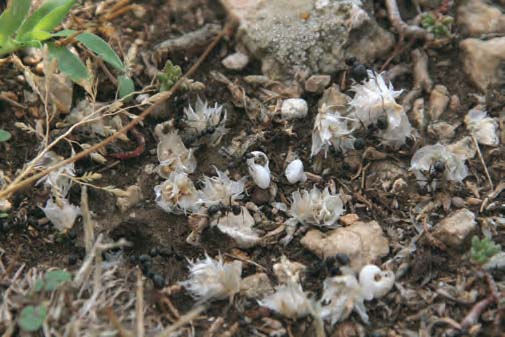|
Ants have evolved into many specialisations from the primitive solitary hunters to the leaf cutter and soldier ants of the tropics. The ant genus Messor includes over one hundred species, all of which are known as harvester ants (the generic name comes from that of Messor, the Roman god of grain and the harvest). Azcarate et. al. (2005) state that Messor harvester ants are “the main seed predators in therophyte grassland and certain types of scrubland in the Mediterranean basin” and that the gathering of seeds that are taken to ant colony stores for eating constitute a severe source of seed mortality for many plant species in such habitats. Of more interest to those of us concerned with molluscs is the fact that although 91% of the Messor “harvest” consists of fruits or seeds, the remainder was found to include “animal fragments”, particularly “insects and excrement” as well as “mineral particles”. On a recent trip to the Black Sea coast of Romania, in a limestone area near Enisala, I came across some harvester ant workers carrying the membranous fruit of a small perennial Paronychia herb into an opening to their underground storage chambers. More interestingly I then noticed that one or two ants were moving small Helicid snail shells as well. Instead of carrying them, they were pushing them up on their side and then down again onto their flattened whorls (see photos). I also noticed that a second ant would sometimes comes along and offer assistance to the first, gradually moving the shell until it was within reach of the entrance to the ants’ underground passageway. There have been reports of snail shells being found in the nests of the ”mud ant” Basicerus singularis in Ecuador (Moffat, 2007) and the striated ant Huberia striata in New Zealand1 . In both these cases (and apparently confirmed in the former case) it is thought that these species of ants capture live snails and bring them into the nest, where they feed on them. I think this is unlikely to be the case for the Messor ants since they are primarily herbivores (but possibly also scavengers). In addition, none of the shells that the ants were carrying appeared to have living occupants, although they may have contained desiccated snail remains. Another reason for these ants predilection for snail shells may be purely that they provide an abundant source of accessible calcium close the nest site. Not being a myrmecologist, it would be interesting to hear of other reports of this type of ant behaviour and/or the reasons behind it. I am sure there must be many references out there that I have not managed to find. References Azcarate F.M., Arqueros L., Sanchez A.M., and Peco B. (2005) Seed and fruit selection by harvester ants, Messor barbarus, in Mediterranean grassland and scrubland. Functional Ecology 19, 273-283 Moffet M.W. (August 2007) Fantastic Ants. National Geographic 1 Encyclopaedia of New Zealand http://www.teara.gov.nz/TheBush/InsectsAndOtherInvertebrates/Ants/2/en. |
Imaes © Peter Topley |
Shell collecting Ants in Romania
Issue
15
Page
9


